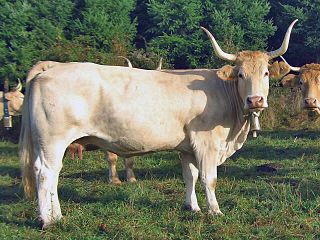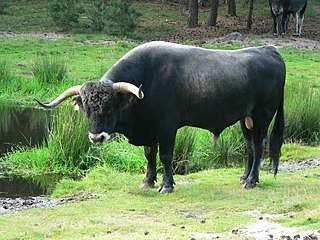 W
WThe Albera is an endangered breed of small cattle indigenous to the Albera Massif, which divides Catalonia from France and lies partly in the comarca of Alt Empordà in the Catalan province of Girona, and partly in the comarca of Vallespir in the French département of Pyrénées-Orientales. The cattle are highly resistant to cold, though susceptible to heat, and are well adapted to the steep terrain of the massif.
 W
WAsturian Mountain is a local Spanish breed of cattle, which possess breeding capacity and docility. They are primarily raised in the east of Asturias, in the north of Spain, particularly in the mountain range of the Picos de Europa, including within the National Park of Covadonga. The breed is also known as the Casina They are beef cattle and one of three breeds used to produce Casín cheese.
 W
WAsturian Valley cattle originate from the valleys of Asturias, Spain. They are mostly raised in the northern coastal areas on the Bay of Biscay and the river valleys at the foot of the Cordillera Cantábrica mountain range. This breed belongs to an exclusive bovine group in Spain known as the tronco Cantábrico that only includes breeds native to northern Spain; it also includes the Asturian Valley cattle. of all those breeds, Asturian Valley maintain the largest number. Traditionally the cattle were used for milk, meat, and work. Since other milk breeds have been introduced to Spain, their prominence has declined in the dairy industry. They remain one of three breeds that may be used to produce Casín cheese.
 W
WThe Berrenda is a type of cattle from the Spanish region of Andalusia. It is subdivided into two breeds; the Red Berrenda and the Black Berrenda. Both breeds are rustic and very well adapted to the environment.
 W
WThe Betizu is a breed of small mountain cattle which live in a semi-feral state in some mountainous parts of the Basque Country in both Spain and France. It is classified as an endangered breed by both the Ministerio de Agricultura, Pesca y Alimentación, the agriculture ministry of Spain, and by the Conservatoire des Races d'Aquitaine in France.
 W
WThe Bruna dels Pirineus, Spanish: 'Bruna de los Pirineos', is a breed of cattle from the south-eastern Pyrenees, in the northern part of Catalonia. It derives from cross-breeding of local cattle with Swiss Braunvieh stock imported in the nineteenth century through France and through the Val d'Aran. It is distributed throughout the northern comarcas of Catalonia, Alta Ribagorça, Alt Urgell, Berguedà, Cerdanya, Pallars Jussà, Pallars Sobirà, Ripollès, Solsonès and Val d'Aran. The Bruna dels Pirineus constitutes about 80% of the beef herd of Catalonia.
 W
WThis is a list of the cattle breeds usually considered to have originated in Spain.
 W
WLimia, Spanish Limiana or in Galician raza Limiá, is a primitive cattle breed from the Province of Ourense in Galicia in northwest Spain, which in some features resembles the extinct aurochs.
 W
WThe Menorquina is an endangered breed of cattle from the Mediterranean island of Menorca, in the Spanish autonomous community of the Balearic Islands. It belongs to the group of convex-profiled red cattle, whose distribution across the northern Mediterranean region is thought to have followed the path of the Bell-Beaker Culture. It is one of only two autochthonous Spanish breeds of dairy cattle, the other being the Pasiega. The milk is particularly suitable for cheese production, and is used to make Mahón cheese, which has DOP status.
 W
WPajuna is a rare Spanish cattle breed, originating in Granada (Andalusia), which resembles the extinct aurochs, the wild ancestor of domestic cattle, in certain features.
 W
WThe Palmera is an endangered breed of cattle from the island of San Miguel de La Palma, in the Spanish autonomous community of the Canary Islands. The cattle are not indigenous to the island, but were brought by European settlers in the fifteenth century. The Palmera derives from the Rubia Gallega breed of Galicia. It is distributed mostly in the municipalities of Breña Alta, Breña Baja, El Paso, Garafía, Los Llanos de Aridane and Villa de Mazo, with small numbers in the municipalities of Puntagorda, Santa Cruz de La Palma and Tijarafe; a few may be found on the islands of Fuerteventura and Tenerife.
 W
WThe Pirenaica, Basque: Behi-gorri, is a breed of beef cattle indigenous to the Pyrenees of north-eastern Spain. It is distributed mainly in the autonomous communities of Navarre and the Basque Country, but is present in much of the northern part of the country. It is well adapted to the mountainous terrain and humid climate of the area. It came close to extinction in twentieth century, but is not now at risk.
 W
WThe Rubia Gallega, Galician: Rubia Galega, is a breed of cattle native to the autonomous community of Galicia in north-western Spain. It is raised mainly for meat. It is distributed throughout Galicia, with about 75% of the population concentrated in the province of Lugo. The coat may be red-blond, wheaten, or cinnamon-coloured.
 W
WThe Sayaguesa is an endangered Spanish breed of domestic cattle. It is named for the comarca of Sayago in the province of Zamora, in the western part of the autonomous community of Castile and León, and is raised almost exclusively in that area. It may also be known as the Zamorana, the Moles de Sayago or the Castellana variedad Sayaguesa. It was traditionally kept mainly for draught work, but is now raised principally for meat.
 W
WThe Spanish Fighting Bull is an Iberian heterogeneous cattle population. It is exclusively bred free-range on extensive estates in Spain, Portugal, France and Latin American countries where bull fighting is organized. Fighting bulls are selected primarily for a certain combination of aggression, energy, strength, and stamina. During the breeding, in order to preserve their natural characteristics, the bulls rarely encounter human beings, and if ever, never on foot.
 W
WThe Terreña, Basque: Behi terreña, is an endangered breed of mountain cattle indigenous to the autonomous community of the Basque Country in northern Spain. It is distributed mostly in the provinces of Álava and Bizkaia, with some localised populations in Gipuzkoa.
 W
WThe Tudanca is a traditional Spanish breed of cattle from Cantabria, in northern Spain. It takes its name from the village of Tudanca in the Comarca de Saja-Nansa in western Cantabria. In the past it was a draught breed, much used for transport of goods to and from the ports of the Cantabrian coast; it is now reared for meat, but is still used in traditional sport of arrastre de piedra, or "stone-dragging". Despite its geographic proximity, it is not closely related to the other cattle breed of Cantabria, the Pasiega.